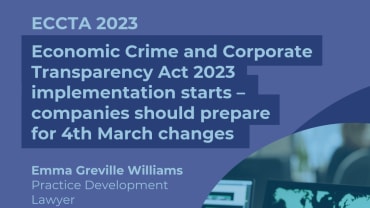Following a recent High Court case, banks and other lenders may find themselves in a better than expected position with respect to a director's personal guarantee. In Fransina Johanna van der Merwe and Gerrit Le Roux Van Der Merwe v IIG Capital LLC, the court construed the document before it - expressed to be a guarantee - as a primary obligation payable "on demand". It followed that the individual guarantors could not rely on the defences which would have been available to the underlying obligor.
A guarantee is a contractual agreement. It creates a secondary obligation to support a primary obligation of one party to another. The guarantor's obligation is contingent on the borrower's primary obligation. A guarantee is to be contrasted with a "performance bond" or "on demand bond". The latter is a specialist banking instrument. It imposes a primary contractual obligation on the issuer to pay a specified sum of money on the happening of a specified event(s). The beneficiary is entitled to payment under an "on demand bond" just by submitting a statement that the underlying obligor is in default of the contract and the beneficiary has suffered a loss. Outside a banking context, there is a strong presumption in case law that the words "on demand" should not be treated as creating a primary obligation. This is particularly the case where guarantors are individuals with no access to the kind of risk management systems which banks have.
In this case, two individual company directors had each entered into a guarantee in respect of a loan made to their company by the claimant. When the company did not repay the loan, the claimant claimed over US$30 million under the guarantee. The directors sought to rely on defences which would have been available to the company. The court had to decide whether they were entitled to rely on such defences and this in turn depended on whether they had undertaken a primary obligation to pay. There was no way in which these individuals could have paid the amount claimed.
The court did not consider it helpful to consider what label should be attached to the instrument. Instead, it set about construing the obligations which the directors had undertaken. Construed in its factual and commercial context, the court held that the above-mentioned "strong presumption" applied. However, there were four clauses in the instrument which displaced it:
- The guarantee provided that a certificate of indebtedness provided by the lender was conclusive and binding on the guarantors in the absence of manifest error. Accordingly, whether or not the debtor company was actually liable under the terms of the loan agreement was irrelevant to the certificate.
- The definition of "Guaranteed Monies" included not only monies actually owed to the lender but also monies "expressed to be due, owing or payable". This suggested that the guarantors' liability was not necessarily being co-extensive with the debtor company's.
- The guarantors were described in the document as "principal obligor and not merely as surety".
- The obligation was to pay on demand.
The judge considered that the first factor was the strongest and that its potency was all the more given that it was accompanied by the other three provisions. He declined to consider whether any of the factors on their own would have been enough.
The language used in this guarantee is not unusual. Banks may find that they are beneficiaries of personal guarantees which contain such language. On the other hand, lawyers advising individuals giving personal guarantees are now likely to scrutinise the language and negotiate each of these clauses. They are likely to seek to include a right for the individual to any defence available to the original obligor.











